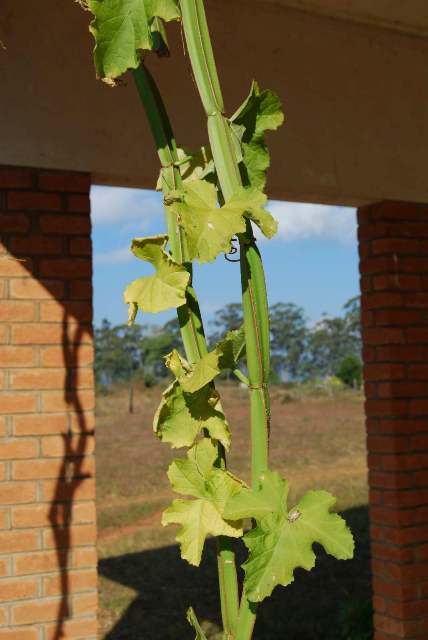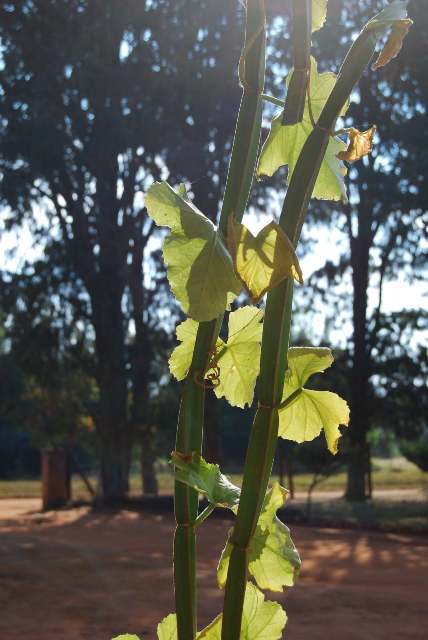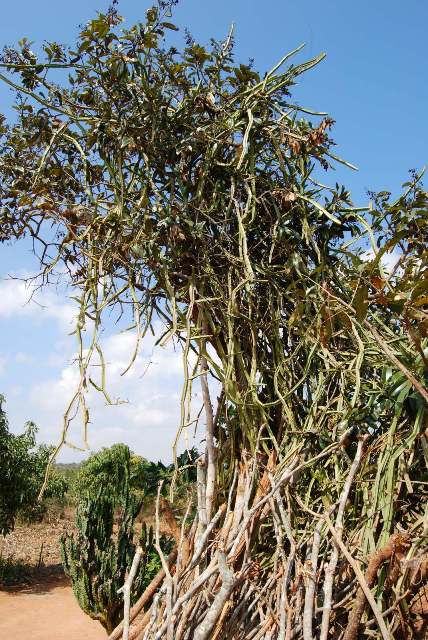Melia volkensii
Fact sheet about Melia volkensii
Distribution and habitat
M. volkensii appears between 350-1680 altitude and where rainfall is 300-800mm. It is common in association with acacia-commiphora vegetation, in bushlands, sometimes along watercourses and on rock outcrops.
Flowering and fruiting habits
It is a deciduous tree up to 20 m tall and 25 cm wide, open crowned and laxly branched. Bark is grey, fairly smooth and furrowing as it ages. Leaves are light green, bipinnate, 3-7 per pinna, up to 35 cm long, hairy when young. Leaflets are oval to lanceolate, tapering to apex with entire or serrated margins, up to 7.5 cm long. Flowers are small, white fragrant and in loose sprays, andromonoecious, with 4-5 petals and stamens are united into a tube. Inflorescence congested up to 12 cm long, axillary. Fruit is oval green to grey, usually 4 cm long with a thick, bony endocarp.
Uses other than pesticidal
Fodder- Popular with farmers for their goats and cattle. Tree is pruned to produce fodder at dry season end.
Apiculture- Used to make log hives as wood is easily shaped. Flowers are good for bee forage.
Timber- As wood is easily shaped, is termite resistant, durable and decay resistant, it is used to make acoustic drums, containers, mortars, doors and window frames, shutters, poles and furniture.
Fuel- Branches cut for fodder are left to dry then used for firewood.
Soil improver- Some farmers have suggested that heavy leaf fall may increase crop yields at later stage of development.
Propagation and cultivation
M. volkensii is naturally dispersed by giraffe, kudus and goats which eat the fruits. Seed germination is difficult. Some have reported germination of seeds after removal of fleshy seed coat and hard shell and soaking of softer inside seed in water and anti-fungal treatment. The seeds are then germinated in sterile, sandy soil. Germination can also be done using root suckers.
Seed collection & Storage
Seeds are extracted from the large fruit by hand.
Seed storage is orthodox and viability can be maintained in hermetic storage at 11-15% mc at room temperature for several years.
Parts used
Leaves
Preparation
Dry and grind
Uses
Can be used both pre and post-harvest
Target organisms
Against broad range of insects
Cissus quadrangularis
Distribution and habitat
It is found in a variety of lowland rainfall habitats, throughout tropical Africa from sea-level up to 2000 m altitude, in Arabia, India, Sri Lanka, Thailand, Vietnam, Indonesia and Philippines.
Flowering and fruiting habits
Succulent climbing herb with tendrils. Stems 4-angled with wings at the angles. Leaves fleshy, very broadly ovate, variously 3-lobed; margin dentate. Inflorescences axillary, few-flowered. Fruit, a rounded fleshy berry, red when ripe. It flowers during the rainy season and sheds leaves during dry season.
Uses other than pesticidal
Traditional medicine- Used for joint and bone health and to treat feminine disorders and menopause.
Propagation and cultivation
C. quadrangularis is propagated with seeds. It can also be propagated with stem cuttings by using three internodes, left to dry, and then planted in a sandy soil.
Seed collection & Storage
One seed is formed in each fruit pod.
Parts used
Fleshy stems and leaves
Preparation
Dry and grind to powder
Uses
Mainly post-harvest uses
Target organisms
Post-harvest beetles
General
Succulent climbing herb with tendrils. Stems 4-angled with wings at the angles. Leaves fleshy, very broadly ovate, variously 3-lobed; margin dentate. Inflorescences axillary, few-flowered. Fruit red when ripe. Found in a variety of low rainfall habitats.
Plant parts with insect-controlling properties
succulent stems and leaves
Zanha africana
Distribution and habitat
Z. africana is found in open woodlands, on granite ridges and sometimes in riverine forests, at 600-1550m altitude, in Kenya, Angola, Mozambique, South Africa, Zimbabwe, Tanzania and Democratic Republic of Congo. In Kenya it occurs in open woodlands and farms, in wooded grasslands in Kiangombe, Makueni and Katumani.
Flowering and fruiting habits
It is a tall shrub or small tree 12-17m tall, bole branchless up to 6m with reddish to brown bark, scaling off in large flakes. Crown open with erect branches; twigs hairy when young. Leaves are alternate, compound with 3-6(-8) pairs of leaflets, stipules absent, petiole 1-5cm long. Inflorescence is terminal or axillary panicle with flowers in dense clusters. Flowers are unisexual, regular, small, greenish, sweet scented, 2.5mm long. Fruit is ellipsoid fleshy drupe reaching 2cm x 2cm, velvety, hairy, yellow to bright orange with one seed which is ellipsoid up to 1.5cm x 1cm.
Uses other than pesticidal
Timber- Wood is used for construction, door frames, tool handles, flooring, ship building, furniture, toys and agricultural implements.
Food- The fruits are eaten by man but can cause severe diarrhoea in eaten in excess. Seeds can be poisonous.
Soap- Saponins are present in root bark, stem bark and fruits.
Medicinal- Traditionally used as a medicine in many African countries. In Tanzania, root decoction used to facilitate child birth, treat constipation and fits. Root preparations are also used to treat toothache, rheumatic pains, pneumonia, vertigo, fungal infections headaches, colds and fever Fodder- Leaves are eaten by cattle, goats and sheep.
Apiculture- The tree is planted for nectar for honey bees.
Propagation and cultivation
Propagation is done with fresh seeds which are recalcitrant. Propagation has been shown to be successful with root and stem cuttings.
Seed collection & Storage
Fruits are collected when mature. Seeds are harvested by hand. Seeds are recalcitrant and should be used fresh. Care should be taken as seeds can be poisonous.
Recalcitrant seeds cannot be stored for long periods of time.
Parts used
Root bark
Preparation
Dry and grind
Uses
Can be used both pre and post-harvest
Target organisms
Against broad range of insects, mainly in storage
Tanacetum cinerariifolium
Distribution and habitat
Pyrethrum was cultivated in Croatia from end 19th century to 1930s when it started decreasing. It was introduced to Kenya in 1928, near Nakuru (Chandler, 1948). It also grows in north west Australia, Tanzania, Rwanda, Ecuador, France and Chile.
Flowering and fruiting habits
Pyrethrum is a perennial herb, 30-100 cm high, with branched shoots terminating into white, daisy-like flower heads, densely arranged. Fruits are pale brown, round with 5-7 ridges, glabrous, with pyrethrum active ingredient born in the tiny oil glands of the achenes.
Uses other than pesticidal
The flowers have been shown to possess weak anti-biotic activity though it is not used medicinally.
Propagation and cultivation
Propagation by seeds by covering lightly in damp soil
Seed collection & Storage
Seeds are collected from the tightly packed flower heads.
Dry seeds are stored in dark, dry cool environment with paper bags.
Parts used
flowers
Preparation
Dry and grind
Chemicals are not easy to extract in water and is often extracted in kerosene
Uses
Can be used both pre and post-harvest
Target organisms
Against broad range of insects
Lantana camara
Distribution and habitat
L. camara is naturalised in many countries in the Asia-Pacific region, Australia, New Zealand, Central and South America, West Indies and Africa.
Flowering and fruiting habits
It is a short vigorous shrub growing up to 2-4 meters in height. Leaves are ovate, 2-10cm long, 2-6cm wide, alternate, bright green, rough, hairy. The stems in cultivated species is non-thorny and in weedy varieties, with prickles. Lantana can climb to 15 m with support. Flower heads contain 20-40 flowers, usually 2.5 cm across, colours vary between white, orange, pink purple and red. Fruit is greenish blue-black, 5-7mm in diameter, shiny with 2 nutlets.
Uses other than pesticidal
Medicinal – Herbal medicines with antimicrobial, fungicidal, insecticidal and nematicidal properties.
Fuel- firewood for cooking.
Food for birds – Many birds including endangered ones feed on lantana thickets. Butterflies and moths also feed on it.
Ornamental- It is popular as ornamental plants in pots or as hedges rendering favourable trade.
Propagation and cultivation
Highly invasive and damaging to local habitats; not to be cultivated or propagated. Simply collect from abundant existing sources.
Seed collection & Storage
Highly invasive and damaging to local habitats; not to be cultivated or propagated.
Parts used
Leaves, flowers
Preparation
Dry and grind
Often layered whole plants in storage, occasional stirring to release volatile compounds
Uses
Can be used both pre and post-harvest.
Target organisms
Against broad range of insects
Mosquito and fly repellent
Post-harvest beetles




